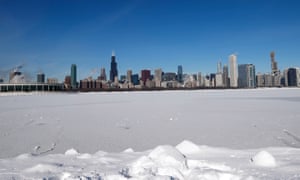Extremes consistent with theories about how emissions could affect weather patterns
Hundreds of thousands of fish have choked during Australia’s hottest month since records began, swathes of the United States is colder than the north pole, new ruptures have been found
in one of the Antarctic’s biggest glaciers and there are growing signs
the Arctic is warming so fast that it could soon be just another stretch
of the Atlantic.
And so the new year is carrying on where the old one left off, with growing signs climate disruption is accelerating at a more destructive rate than many scientists predicted.
The US deep freeze, which has plunged temperatures in Minnesotato -50C (-58F), may appear to have little in common with the searing heatwave that cooked Marble Bar, Australia, in 49.1C. But the extremes are consistent with theories about how increasing human emissions change major weather systems.
As carbon builds in the atmosphere, the planet warms and the ice caps
melt, so the temperature gradient between the equator and the poles
flattens out. Although the science is not yet conclusive, many
scientists believe this is weakening the jet streams, which are
important drivers of weather systems.And so the new year is carrying on where the old one left off, with growing signs climate disruption is accelerating at a more destructive rate than many scientists predicted.
The US deep freeze, which has plunged temperatures in Minnesotato -50C (-58F), may appear to have little in common with the searing heatwave that cooked Marble Bar, Australia, in 49.1C. But the extremes are consistent with theories about how increasing human emissions change major weather systems.
During the summer, this means high-pressure fronts linger for longer causing heatwaves such as those in parts of the northern hemisphere last May, June and July, and in the southern hemisphere over the past two months. During the northern winter, it loosens the polar vortex, which lets the warmer southern air in, causing the freakishly high Arctic temperatures recorded last winter, and allows the frozen air out, which is being seen in the US. This also manifested itself last year in Europe as “the Beast from the East”.
In October, the United Nation’s top climate science body – the Intergovernmental Panel on Climate Change – warned that North America and Australia were among the areas likely to feel the impact of significant rises in extreme heat.

“That is why nobody can claim with confidence that we will be able to cope with all the impacts that everyone can see are developing around the world, including more extreme droughts, heavy rainfall, and heatwaves, disappearing glaciers and ice caps, rising sea levels and acidifying oceans.”

No comments:
Post a Comment